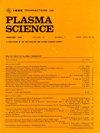快速触发冷阴极开关及其放电电路的延迟和抖动特性
IF 1.5
4区 物理与天体物理
Q3 PHYSICS, FLUIDS & PLASMAS
引用次数: 0
摘要
基于增强畸变电场的气体放电理论,改进了三极火花隙开关的延时计算公式,提高了理论预测的准确性。此外,还全面研究了火花隙开关的延迟和抖动与触发电压、工作电压、气体压力和主电极间距变化的关系。从微观粒子的角度,阐明了这些因素影响击穿延迟和放电抖动的物理机制。通过比较各因素的影响程度,确定了TEA CO2激光器作为负载条件下影响火花隙开关击穿延迟和抖动的最关键因素,并进一步减小了放电抖动。实验结果表明,工作电压和触发电压的上升速率是影响火花隙开关延时和抖动的关键参数,其他因素的影响相对较小。修正后的延迟计算公式与实验结果吻合较好。该研究不仅为延迟预测提供了参考,而且为基于同步脉冲放电的激光振荡放大器系统提供了低抖动的解决方案。本文章由计算机程序翻译,如有差异,请以英文原文为准。
Delay and Jitter Characteristics of Fast-Triggered Cold Cathode Switches and Their Discharge Circuits
Based on gas discharge theory incorporating enhanced distorted electric fields, refines the delay calculation formula for three-electrode spark-gap switches, thereby improving the accuracy of theoretical predictions. Additionally, the relationships between the delay and jitter of the spark-gap switch and variations in trigger voltage, operating voltage, gas pressure, and main electrode spacing were comprehensively examined. From the perspective of microscopic particles, the physical mechanisms by which these factors influence breakdown delay and discharge jitter were elucidated. By comparing the magnitude of each factor’s impact, the most critical factors affecting the breakdown delay and jitter of the spark-gap switch under conditions using a TEA CO2 laser as a load were identified, and discharge jitter was further reduced. Experimental results indicate that the rise rates of operating voltage and trigger voltage are the key parameters affecting the delay and jitter of the spark-gap switch, while the influence of other factors is relatively minor. Furthermore, the corrected delay calculation formula aligns well with the experimental results. This research not only provides a reference for delay prediction but also offers a low-jitter solution for laser oscillator-amplifier systems based on synchronized pulse discharge.
求助全文
通过发布文献求助,成功后即可免费获取论文全文。
去求助
来源期刊

IEEE Transactions on Plasma Science
物理-物理:流体与等离子体
CiteScore
3.00
自引率
20.00%
发文量
538
审稿时长
3.8 months
期刊介绍:
The scope covers all aspects of the theory and application of plasma science. It includes the following areas: magnetohydrodynamics; thermionics and plasma diodes; basic plasma phenomena; gaseous electronics; microwave/plasma interaction; electron, ion, and plasma sources; space plasmas; intense electron and ion beams; laser-plasma interactions; plasma diagnostics; plasma chemistry and processing; solid-state plasmas; plasma heating; plasma for controlled fusion research; high energy density plasmas; industrial/commercial applications of plasma physics; plasma waves and instabilities; and high power microwave and submillimeter wave generation.
 求助内容:
求助内容: 应助结果提醒方式:
应助结果提醒方式:


